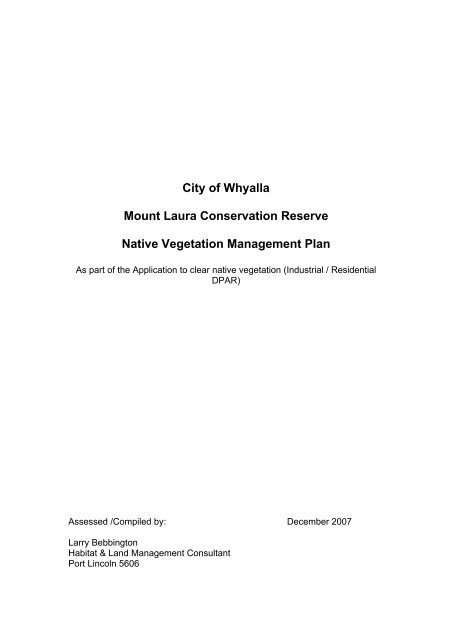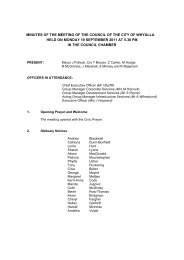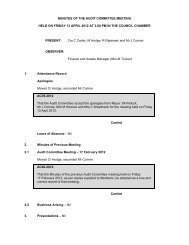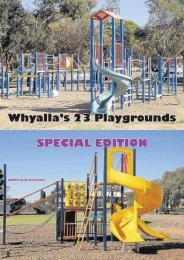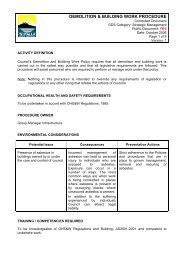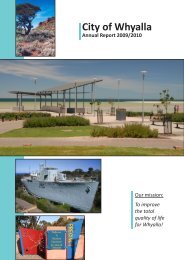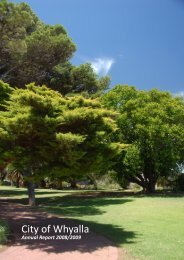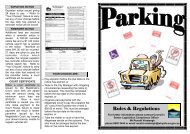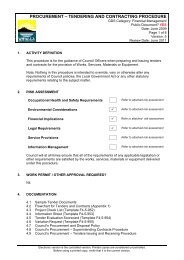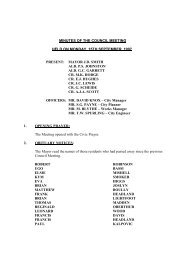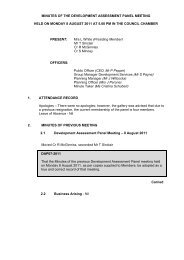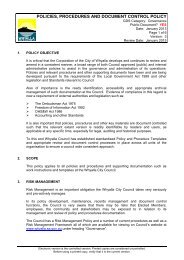Mt Laura Reserve Native Vegetation Plan 2009/10 - City of Whyalla
Mt Laura Reserve Native Vegetation Plan 2009/10 - City of Whyalla
Mt Laura Reserve Native Vegetation Plan 2009/10 - City of Whyalla
You also want an ePaper? Increase the reach of your titles
YUMPU automatically turns print PDFs into web optimized ePapers that Google loves.
<strong>City</strong> <strong>of</strong> <strong>Whyalla</strong>Mount <strong>Laura</strong> Conservation <strong>Reserve</strong><strong>Native</strong> <strong>Vegetation</strong> Management <strong>Plan</strong>As part <strong>of</strong> the Application to clear native vegetation (Industrial / ResidentialDPAR)Assessed /Compiled by: December 2007Larry BebbingtonHabitat & Land Management ConsultantPort Lincoln 5606
FINAL DRAFT2Document InformationJob/Project Title:<strong>Native</strong> <strong>Vegetation</strong> Management <strong>Plan</strong> for vegetation clearance <strong>of</strong>fsetTitle:Mount <strong>Laura</strong> Conservation <strong>Reserve</strong> <strong>Native</strong> <strong>Vegetation</strong> Management <strong>Plan</strong>Client Organisation:Corporation <strong>of</strong> the <strong>City</strong> <strong>of</strong> <strong>Whyalla</strong>Document ID:Date:Revision Status:Assessor:282 A MEIMP/CoW/07December 2007Final DRAFTLarry BebbingtonCurrent Document Approval:Stewart Payne – Group Manager Development ServicesThis work is copyright. Apart from any use permitted underthe Copyright Act, no part may be reproduced by any process,or any other exclusive right exercised,without the permission <strong>of</strong>:Larry A. BebbingtonP.O. Box 1235North Shields South Australia 5607Index© L. Bebbington – Habitat & Land Management Consultant – 86845065- lbebb@bordernet.com.au
FINAL DRAFT31.0 – Background………………………………………………………………..41.1- Ownership Details………………………………………………………….5Map 1 – 1:50 000 <strong>of</strong> Land under application………………………………….5Map 2 – Aerial Overview ………………………………………………………..61.2 – Property Description……………………………………………………….71.3 – <strong>Native</strong> vegetation…………………………………………………………..71.3.1 – Pre European…………………………………………………….7,81.3.2 – Current <strong>Plan</strong>t Associations……………………………………9,<strong>10</strong>Table 1 – <strong>Native</strong> <strong>Vegetation</strong> Recorded………………………………………11,12Table 2 – Weeds Recorded……………………………………………………12Map 3 – Aerial - <strong>Vegetation</strong> Communities ……………………………………131.3.3 – Rare <strong>Plan</strong>t Species……………………………………………..141.3.4 – Remnancy Data………………………………………………..141.4 – Fauna and Habitat Values……………………………………………. .14,15Table 2 – <strong>Native</strong> Fauna Recorded……………………………………………..161.5 – Summary <strong>of</strong> Conservation Values……………………………………….172.0 – Set Aside……………………………………………………………. …….172.1 – General Threats & Management Actions……………………………….17Map 4 -Condition <strong>of</strong> <strong>Vegetation</strong>………………………………………………..18Map 5 - <strong>Mt</strong> <strong>Laura</strong> Cons <strong>Reserve</strong> Threats & Actions………………………… 193.0 – Action <strong>Plan</strong>s…………………………………………………………………203.1 – Vehicle Access……………………………….………………… 20,213.1.2- Recreational Off-Road Vehicle Access Area………………..21,223.2 – Pest <strong>Plan</strong>ts & Animals…………………………………………..22,233.3 – Erosion Control………………………………………………….23,243.4 – Revegetation Works………………………………………………..242.4 – Action Time Tables…………………………………………………………252.5 – Cost Estimates / Schedules……………………………………… …..26-28- Estimated 5 year budget……………………………………………………293.0 – Monitoring, Adaptation and Review……………………………………….30Appendix 1 – Site Photographs………………………………………………31-35Background© L. Bebbington – Habitat & Land Management Consultant – 86845065- lbebb@bordernet.com.au
FINAL DRAFT4The area identified as suitable for a trade <strong>of</strong>f / SEB area for proposedclearance identified in the <strong>City</strong> <strong>of</strong> <strong>Whyalla</strong> DPAR (May 2007) was assessedduring the PAR rezoning surveys by Larry Bebbington (Accredited NVCAssessor).Conditional consent was granted by the <strong>Native</strong> <strong>Vegetation</strong> Council on 21 stAugust 2007 to adopt the concept <strong>of</strong> using the 1800ha <strong>Mt</strong> <strong>Laura</strong> Conservation<strong>Reserve</strong> as a credit bank to <strong>of</strong>fset clearance identified in the clearanceproposal presented to the <strong>Native</strong> <strong>Vegetation</strong> Council (Berri - 2cnd August 2007).Conditional consent involved utilising Regulations 5 1 (ab) and (d) for the<strong>Whyalla</strong> Industrial Park and areas identified in the <strong>City</strong> <strong>of</strong> <strong>Whyalla</strong> DPAR andthe set aside <strong>of</strong> land subtracted from the <strong>Mt</strong> <strong>Laura</strong> “credit bank” at theappropriate approved set aside ratio.The <strong>Mt</strong> <strong>Laura</strong> set aside area is classified as (i) Remnant – more or less intactin structure, composition and diversity.Conditional consent was granted by the NVC to allow continuing public use <strong>of</strong>the <strong>Mt</strong> <strong>Laura</strong> set aside reserve by community groups such as Orienteers,Bushwalking Groups and the <strong>Whyalla</strong> 4WD Club. Community usage will followguidelines proposed in the form <strong>of</strong> a MOU which will be approved by allparties. Community groups operating under an MOU will abide by theconditions <strong>of</strong> consent as set by the NVC and by the requirements <strong>of</strong> theapproved <strong>Native</strong> <strong>Vegetation</strong> Management <strong>Plan</strong> (NVMP). Compliance will bepoliced by authorised <strong>of</strong>ficers <strong>of</strong> the <strong>City</strong> <strong>of</strong> <strong>Whyalla</strong>’s Environment Unit.The area proposed for trade <strong>of</strong>f is located on Lot 2 DP 56203 Hundred <strong>of</strong>Cultana and covers an area <strong>of</strong> approximately 1800 Ha which adjoins the<strong>Whyalla</strong> Conservation Park in the north, the Lincoln Highway to the east andthe Iron Knob Road in the south. See topo map below for GPS points.1.0 – Ownership DetailsThe proposed conservation reserve falls within a proposed ConservationZone (PAR May 2007) on Allotment 2 <strong>of</strong> Deposited <strong>Plan</strong> 56203, Hundred <strong>of</strong>Cultana, Certificate <strong>of</strong> Title Volume 5852 Folio 784 owned by the Corporation<strong>of</strong> the <strong>City</strong> <strong>of</strong> <strong>Whyalla</strong>.Map 1 – 1:50000 topographical <strong>of</strong> Set Aside Area© L. Bebbington – Habitat & Land Management Consultant – 86845065- lbebb@bordernet.com.au
FINAL DRAFT5Map 2 – Overview <strong>of</strong> <strong>Mt</strong> <strong>Laura</strong> Conservation Res. and Industrial© L. Bebbington – Habitat & Land Management Consultant – 86845065- lbebb@bordernet.com.au
FINAL DRAFT61.2 – Property Description and Land Use© L. Bebbington – Habitat & Land Management Consultant – 86845065- lbebb@bordernet.com.au
FINAL DRAFT7The landforms vary from outwash plains to the north and east and incorporaterocky rounded hills in the south west section which range in height from <strong>10</strong>0to 180m at Mount <strong>Laura</strong>. <strong>Mt</strong> <strong>Laura</strong> and surrounding hills are dominated byfeldspar rich coarse Arkose sandstone.The foothills and outwash plainscontain numerous drainage depressions and ephemeral watercourses whichpredominately flow to the east across the outwash plains.Historically the area was utilised for limited stock grazing followed by thepurchase <strong>of</strong> the land by BHP as a buffer zone and a stormwater harvestingproject for re-use in the smelter.BHP installed the Barson Water Catchment system between 1937-38 whichconsisted <strong>of</strong> large scale herringbone patterned drainage lines in the southernsection <strong>of</strong> the proposed set aside area. Ownership <strong>of</strong> Allotment 2 wastransferred to the Corporation <strong>of</strong> the <strong>City</strong> <strong>of</strong> <strong>Whyalla</strong> in 2003 by Onesteel asthe company rationalised their assets.During the period <strong>of</strong> BHP ownership the proposed conservation area wasutilised by <strong>of</strong>f road vehicles (ORV’s) which has left a legacy <strong>of</strong> eroding trackspredominately in the south western area. Unrestricted vehicular access will beaddressed as part <strong>of</strong> the overall management plan for the area.The sandy clays over rubble on slopes and outwash plains are prone toerosion following disturbance and/or during high intensity short durationrainfall events in the summer periods.No fire history is available for the area.1.3– <strong>Native</strong> <strong>Vegetation</strong>1.3.1– Pre European vegetationPre-European vegetation associations would not have been dissimilar toexisting associations found within the site today. Following settlementclearance and disturbances have been restricted to stormwater drainagesystems and the network <strong>of</strong> ORV tracks which have confined impacts andhave not altered the overall plant associations or the biodiversity <strong>of</strong> the areaon a landscape scale.The BHP Barson Water Catchment Scheme (1938) impacted on Low OpenWoodland in the lower southern sections <strong>of</strong> the proposed set aside and todaythe Chenopod Low Shrubland that has regenerated does not represent thehistorical plant communities.Pre-European plant associations did not include dense infestations <strong>of</strong> WardsWeed or weed species such as Carrion Flower.Historical plant communities would have consisted <strong>of</strong>:© L. Bebbington – Habitat & Land Management Consultant – 86845065- lbebb@bordernet.com.au
FINAL DRAFT8Acacia papyrocarpa (Western Myall) Low Open Woodland +/- Myoporumplatycarpum with Chenopod shrubs such as Atriplex vesicaria (Bladder SaltBush), Maireana sedifolia (blue bush), Maireana pyramidata (Blackbush),Scaevola spinescens (Spiny Fanflower),Lycium australe (<strong>Native</strong> Boxthorn),Senna artemisioides (Desert Senna), Eremophila scoparia (Broom EmuBush), Sida corrugata (dwarf sida), Austrostipa nitida (Balcarra Speargrass),Austrodanthonia caespitosa (Common Wallaby Grass) and emergentMyoporum montanum (<strong>Native</strong> Myrtle), Alectryon oleifolium (Bullock Bush).Casuarina pauper (Black Oak) Low Open Woodland +/- Eremophila scoparia(Broom Emu Bush), Senna artemisioides (Desert Senna), Myoporummontanum (<strong>Native</strong> Myrtle). The understorey may have consisted <strong>of</strong> Maireanasedifolia (Blue Bush), Atriplex vesicaria (Bladder Salt bush), Scaevolaspinescens (Spiny Fan Flower), Lycium australe (<strong>Native</strong> boxthorn),Austrostipa nitida (Balcarra speargrass), Sida intricata (Twiggy Sida),Zygophyllum aurantiacum (Soapbush).Myoporum platycarpum (False Sandalwood) Low Open Woodland +/- withChenopod shrubs such as Atriplex vesicaria (Bladder Salt Bush), Maireanasedifolia (blue bush), Maireana pyramidata (Blackbush), Scaevola spinescens(Spiny Fanflower),Lycium australe (<strong>Native</strong> Boxthorn), Senna artemisioides(Desert Senna), Eremophila scoparia (Broom Emu Bush), Sida corrugata(dwarf sida), Austrostipa nitida (Balcarra Speargrass), Austrodanthoniacaespitosa (Common Wallaby Grass) and emergent Myoporum montanum(<strong>Native</strong> Myrtle), Alectryon oleifolium (Bullock Bush).Maireana sedifolia (Blue bush)/ Atriplex vesicaria (Bladder Salt Bush)Chenopod Low Shrubland (5) +/- Mid Dense to Dense Maireana pyramidata(Black Bluebush), Eremophila scoparia (Silver Leaf Emu Bush), Eremophilalongifolia ((Weeping Emu Bush), Dodonaea viscosa (Narrow Leaf Hop Bush),Santalum acuminatum (Quandong). The Sparse to Mid-Dense Understorey:Lycium australe (<strong>Native</strong> Boxthorn), Scaevola spinescens (Spiny Fan Flower),Euphorbia tannensis ssp eremophila (Desert Spurge) Enchylaena tomentosa(Ruby Saltbush), Sclerolaena diacantha (Grey bindii), Solanum ellipticum(Velvet Potato Bush), Austrostipa nitida (Spear Grass), Austrodanthoniacaespitosa (Common Wallaby Grass), Sida intricata( (Twiggy Sida),Sarcozona praecox (Noon Flower), Ptilotus obovatus (Cotton Bush).Eremophila scoparia (Broom Emu Bush) / Senna artemisioides complex(Desert Senna) Tall Shubland +/- Acacia ligulata (Umbrella wattle), Myoporumplatycarpum (False Sandalwood), Santalum acuminatum (Quandong),Dodonaea viscosa ssp angustissima (Narrow Leaf Hop Bush), Dodonaealobulata (Lobed Leaf Hop Bush). The understorey would have consisted <strong>of</strong>Mid-Dense Maireana pyramidata (Blackbush), Scaevola spinescens (SpinyFan Flower), Maireana sedifolia (Bluebush), Atriplex vesicaria (BladderSaltbush), Enchylaena tomentosa (Ruby Saltbush), Austrostipa nitida(Balcarra speargrass), Austrostipa scabra ssp. scabra (Rough Speargrass),Sida intricata (Twiggy Sida).© L. Bebbington – Habitat & Land Management Consultant – 86845065- lbebb@bordernet.com.au
FINAL DRAFT91.3.2 – Current <strong>Plan</strong>t AssociationsThe following plant communities and species have been recorded andmapped on site. The species list (53sp.) is not exhaustive but highlights thatthe area contains more or less intact plant communities and diversity and theopportune faunal list indicates that biodiversity values are high.The dominant plant communities consist <strong>of</strong>:Maireana sedifolia (Blue bush)/ Atriplex vesicaria (Bladder Salt Bush)Chenopod Low Shrubland (5) STATUS R (Neagle 1995 ) +/- Mid Dense to DenseMaireana pyramidata (Black Bluebush), Eremophila scoparia (Silver Leaf EmuBush), Eremophila longifolia ((Weeping Emu Bush), Dodonaea viscosa(Narrow Leaf Hop Bush), Santalum acuminatum (Quandong). The Sparse toMid-Dense Understorey consists <strong>of</strong>: Lycium australe (<strong>Native</strong> Boxthorn),Scaevola spinescens (Spiny Fan Flower), Euphorbia tannensis ssperemophila (Desert Spurge) Enchylaena tomentosa (Ruby Saltbush),Sclerolaena diacantha (Grey bindii), Solanum ellipticum (Velvet Potato Bush),Austrostipa nitida (Spear Grass), Austrodanthonia caespitosa (CommonWallaby Grass), Sida intricata( (Twiggy Sida), Sarcozona praecox (NoonFlower), Ptilotus obovatus (Cotton Bush). Overall the condition class <strong>of</strong> theChenopod Low Shrublands within the trade <strong>of</strong>f area is classified as M Neagle1995and the HSR Score B 375 . Weed invasion is relatively low with the exception <strong>of</strong>Wards Weed which becomes Dense in areas containing sparse shrubland.Orbea variegata (Carrion Flower) is scattered throughout chenopodcommunities and densities vary from Sparse to Mid-Dense (C. Garrett pers.com).Acacia papyrocarpa (Western Myall) Low Open Woodland STATUSRARE Regionally (Neagle 1995 ) +/- Myoporum platycarpum with semi-succulentshrubs such as Atriplex vesicaria (Bladder Salt Bush), Maireana sedifolia(blue bush), Maireana pyramidata (Blackbush), Scaevola spinescens (SpinyFanflower),Lycium australe (<strong>Native</strong> Boxthorn), Senna artemisioides (DesertSenna), Eremophila scoparia (Broom Emu Bush), Sida corrugata (dwarf sida),Austrostipa nitida (Balcarra Speargrass), Austrodanthonia caespitosa(Common Wallaby Grass) and emergent Myoporum montanum (<strong>Native</strong>Myrtle), Alectryon oleifolium (Bullock Bush). The condition class <strong>of</strong> theWestern Myall Low Open Woodland within the trade <strong>of</strong>f area is classified asS 2 Neagle1995 and the HSR Score A 400 ,particularly along drainage lines orephemeral watercourses.Casuarina pauper (Black Oak) Low Open Woodland STATUS RARE Regionally(Neagle 1995 ) +/- Eremophila scoparia (Broom Emu Bush), Senna artemisioides(Desert Senna), Myoporum montanum (<strong>Native</strong> Myrtle). The understoreyconsists <strong>of</strong> Maireana sedifolia (Blue Bush), Atriplex vesicaria (Bladder Saltbush), Scaevola spinescens (Spiny Fan Flower), Lycium australe (<strong>Native</strong>boxthorn), Austrostipa nitida (Balcarra speargrass), Sida intricata (TwiggySida), Zygophyllum aurantiacum (Soapbush). The condition class <strong>of</strong> BlackOak Open Woodland in the north west is considered to be S 2 Neagle1995 .TheHSR Score <strong>of</strong> the Black Oak woodland is considered to be A 400 as this© L. Bebbington – Habitat & Land Management Consultant – 86845065- lbebb@bordernet.com.au
FINAL DRAFT<strong>10</strong>community provides habitat and food for a variety <strong>of</strong> avifauna. Weed invasionis restricted to Mid Dense Wards Weed.Myoporum platycarpum (False Sandalwood) Low Open WoodlandSTATUSTHREATENED Regionally (Neagle 1995 ) +/- with semi-succulent shrubssuch as Atriplex vesicaria (Bladder Salt Bush), Maireana sedifolia (blue bush),Maireana pyramidata (Blackbush), Scaevola spinescens (SpinyFanflower),Lycium australe (<strong>Native</strong> Boxthorn), Senna artemisioides (DesertSenna), Eremophila scoparia (Broom Emu Bush), Sida corrugata (dwarf sida),Austrostipa nitida (Balcarra Speargrass), Austrodanthonia caespitosa(Common Wallaby Grass) and emergent Myoporum montanum (<strong>Native</strong>Myrtle), Alectryon oleifolium (Bullock Bush). The condition class <strong>of</strong> theMyoporum platycarpum Low Open Woodland within the trade <strong>of</strong>f area isclassified as S 2 Neagle1995 and the HSR Score A 400 ,particularly along drainagelines or ephemeral watercourses.Eremophila scoparia (Broom Emu Bush) / Senna artemisioides (DesertSenna) Tall Shrubland STATUS R (Neagle 1995 ) +/- Acacia ligulata (Umbrellawattle), Myoporum platycarpum (False Sandalwood), Santalum acuminatum(Quandong), Dodonaea viscosa ssp angustissima (Narrow Leaf Hop Bush),Dodonaea lobulata (Lobed Leaf Hop Bush). The understorey consists <strong>of</strong>Sparse to Mid-Dense Maireana pyramidata (Blackbush), Scaevola spinescens(Spiny Fan Flower), Maireana sedifolia (Bluebush), Atriplex vesicaria (BladderSaltbush), Enchylaena tomentosa (Ruby Saltbush), Austrostipa nitida(Balcarra speargrass), Austrostipa scabra ssp. scabra (Rough Speargrass),Sida intricata (Twiggy Sida). Tall Shrublands dominate drainage depressionsand ephemeral watercourses throughout the proposed trade <strong>of</strong>f area andoverall the condition class is S 2 - M Neagle1995 with weed invasion generallyrestricted to Wards Weed and Sparse Orbea variegata (Carrion Flower). TheHSR Score <strong>of</strong> Tall Shrubland along drainage lines is considered A 400 as themosaic <strong>of</strong> vegetation provides linkages to adjoining landforms and providesknown habitat for species such as the Thick Billed Grass Wren.Triodia irritans Hummock Grassland STATUS R (Neagle 1995 ) +/- sclerophyllousshrubs such as – Sida corrugata (Corrugated Sida), Scaevola spinescens(Spiny Fan Flower), Ptilotus ssp. (Pussy Tails). Hummock grasslands arefound on some west facing hillslopes and adjoining foot slopes and a HSRScore <strong>of</strong> A 400 applies as these grasslands provide food and habitat for faunasuch as the Thick Billed Grass Wren and local herpifauna.Table 1 – <strong>Native</strong> <strong>Vegetation</strong> – <strong>Mt</strong>. <strong>Laura</strong> Conservation <strong>Reserve</strong>© L. Bebbington – Habitat & Land Management Consultant – 86845065- lbebb@bordernet.com.au
FINAL DRAFT11Species Name Common Name STATUS DensityAUS SA EPAcacia ligulata Umbrella wattle MD-DAcacia oswaldii Oswald’s wattle MDAcacia papyrocarpa Western Myall MD-DAlectryon oleifolium Bullock Bush MD-DAmyema quandang Grey Mistletoe VSArabidella trisecta Shrubby cress SAtriplex holocarpa Pop saltbush MDAtriplex spongiosa Pop saltbush R SAtriplex vesicaria bladder saltbush MD-DAustrodanthoniaCommon wallabyScaespitosagrassAustrodanthonia setacea v Small floweredS-MDsetaceawallaby grassAustrostipa elegantissima Elegant spear grass SAustrostipa nitida Balcarra spear grass MDAustrostipa scabra ssp Rough spear grassS-MDscabraChamaesyce (ft.Caustic weedMDEuphorbia) drummondiiChenopodium desertorum Desert Goosefoot SChloris truncata Windmill grass VSConvolvulus remotus Common bindweed MDDissocarpus biflorus Twin Horns MDDissocarpus paradoxus Ball bindyi SEnchylaena tomentosa Ruby Saltbush MDErodiophyllum elderi Hard Heads VSErodium cygnorum Wild Geranium MDEremophila longifolia Weeping emu bush SEremophila scoparia Broom Emu Bush MDExocarpus aphyllus <strong>Native</strong> Cherry VSGunniopsis kochii Pigface SLycium australe <strong>Native</strong> boxthorn S-MDMaireana appressa Appressed Blue Bush SMaireana georgei Satiny Blue Bush SMaireana pyramidata Sago Bush S-MDMaireana pentatropis bluebush SMaireana sedifolia Pearl blue bush MD-DMyoporum montanum <strong>Native</strong> Myrtle SMyoporum platycarpum False Sandalwood S-MDRhagodia parabolica Mealy saltbush VS 1Rhagodia ulicina Intricate saltbush S - MDRhagodia spinescens Spiny saltbush S-MDSalsola kali Buckbush SSclerostegia obliquicuspis Bindyi SSenna artemisioides Desert Senna MDSenna artemisioides f.coriaceaDesert sennaMD© L. Bebbington – Habitat & Land Management Consultant – 86845065- lbebb@bordernet.com.au
FINAL DRAFT12Sida calyxhymenia Tall sida MD-DSida fibulifera Pin Sida K MDSida intricata Twiggy sida MDSolanum ellipticum Velvet potato bush STetragonia tetragonoides Dryland spinach STriodia irritans Spinifex MD-DVittadinia cuneataWoolly new HollandS-MDdaisyZygophyllum aurantiacum Soapbush SZygophyllum apiculatum Common twin leaf MDZygophyllum billardieri Coast twinleafMD(inland form)Zygophyllum crenatum Lobed twin leaf STable 2 – Introduced <strong>Plan</strong>ts RecordedSpecies Name Common Name DensityAcetosa vesicaria Hop Bush VSAsphodelus fistulosus Wild Onion SBrassica tournefortii Wild radish VSCarrichtera annua Wards Weed DCucumis myriocarpus Prickly Paddy Melon VSEchium plantagineum Salvation Jane VS-SEuphorbia terracina False Caper VSHordeum leporinum Barley Grass VSMarrubium Vulgare Horehound VSOpuntia sp. Prickly Pear VSOrbea variegata Carrion Flower SSalvia verbenaca Wild Sage VSMap 3 – <strong>Vegetation</strong> Communities Conservation <strong>Reserve</strong>© L. Bebbington – Habitat & Land Management Consultant – 86845065- lbebb@bordernet.com.au
FINAL DRAFT131.3.3 – Rare <strong>Plan</strong>t Species or Communities© L. Bebbington – Habitat & Land Management Consultant – 86845065- lbebb@bordernet.com.au
FINAL DRAFT14Atriplex spongiosa is classified as Rare on Eyre Peninsula (although it isrelatively common in adjoining Gardiner Torrens region) and Sida fibuliferastatus is classified as unknown K . Extensive botanical surveys may identifyseveral other plant species <strong>of</strong> significance within the proposed conservationarea.Acacia papyrocarpa (Western Myall) Low Open Woodland is classified asRARE regionally and is well represented in the proposed conservation area.Furthermore significant numbers <strong>of</strong> seedlings have germinated post 2007autumn rains (160mm 24 hours) which should survive to maturity given thelow number <strong>of</strong> herbivores and rabbits in the area.Casuarina pauper (Black Oak) Low Open Woodland is classified as RAREregionally and is well represented in the western and northern areas <strong>of</strong> theproposed conservation area.Myoporum platycarpum (False Sandalwood) Low Open Woodland isclassified as THREATENED regionally but is relatively common within thesite. As with A. papyrocarpa significant numbers <strong>of</strong> seedlings havegerminated post 2007 rains and the majority should reach maturity.There is a high probability that Pterostylis sp. Eyre peninsula R. Bates 19474 whichis flagged under the EPBC Act 1999 as Vulnerable AUS,SA exist within the <strong>Mt</strong><strong>Laura</strong> reserve due to suitable rocky habitat existing across much <strong>of</strong> the site.1.3.4 – Remnancy DataThe Hundred <strong>of</strong> Cultana contains 91.7% remnant vegetation <strong>of</strong> which only3.8% (462ha) is protected.The <strong>Whyalla</strong> Association contains 95.9% vegetation in the association.The inclusion <strong>of</strong> the <strong>Mt</strong> <strong>Laura</strong> Conservation reserve as an extension <strong>of</strong> theboundary <strong>of</strong> the <strong>Whyalla</strong> Conservation Park would effectively double the size<strong>of</strong> the Conservation Park.1.4 – Fauna and Wildlife Habitat ValuesDue to the landforms and overall intactness and diversity <strong>of</strong> plant communitiesthe proposed <strong>Mt</strong> <strong>Laura</strong> Conservation <strong>Reserve</strong> contains a mosaic <strong>of</strong> differenthabitats for a range <strong>of</strong> native fauna.Habitats range from large rock outcrops, hillslopes with broken rubble andHummock grasslands, tall shrublands in steep gullies, clearings containingnative tussock grasslands, low open woodland with tree hollows, drainagedepressions with dense perennial shrubs and exposed rock and saltbushplains with native grassland and emergent low trees.© L. Bebbington – Habitat & Land Management Consultant – 86845065- lbebb@bordernet.com.au
FINAL DRAFT15Avifauna is well represented within the reserve area as the diversity <strong>of</strong>flowering shrubs and trees provide nectar, habitat and insects throughout theyear.Of particular interest are the records <strong>of</strong> Amytornis textilis (Thick Billed GrassWren) V EP,SA,AUS , which utilises tall shrubland within gullies as corridors to theadjacent conservation park. These tall shrublands are connected to favouredhabitat provided by Triodia irritans Hummock Grasslands on the west facingslopes <strong>of</strong> hills on the western boundary.Whilst herpifauna records are opportune they indicate that a range <strong>of</strong> reptilesutilise suitable habitat particularly in the rocky hillsides. Species recordedwere all relatively common.Records <strong>of</strong> invertebrates are scarce for the area and the adjoining <strong>Whyalla</strong>conservation park but field observations during vegetation surveys indicatethat a wide range <strong>of</strong> invertebrates inhabit the area, particularly arachnids. It isprobably that the number <strong>of</strong> arachnids species utilising habitat within thereserve would exceed <strong>10</strong>0.Invertebrates play an important role in the pollination <strong>of</strong> native plants andprovide food sources for avifauna and mammals such as Dunnarts.The most visible mammals within the proposed reserve are small numbers <strong>of</strong>Macropus fuliginosus (Western Grey Kangaroo) and Macropus robustus(Euro). Tracks and scats <strong>of</strong> Dunnarts (Sminthopsis sp.) have been recordedalong drainage lines in the northern section and 3 species (S. crassicaudata,S. macroura and S. murina) have been recorded in the adjacent <strong>Whyalla</strong>Conservation Park (Management <strong>Plan</strong> for the <strong>Whyalla</strong> Conservation Park 1998-FOWCP).Amphibians are represented by Limnodynastes tasmeniensis (Spotted GrassFrog) and Neobatrachus pictus (Trilling Frog) which were recorded during lateautumn surveys.Overall the habitat values for the reserve are classified as Very Good 1 or aHSR Score <strong>of</strong> A 400 and a LCR Category <strong>of</strong> Good 2.5 .Habitat & Ecological Ratings: (Bebbington L. - 1996): Ratings based on suitable available habitat fornative fauna (reptiles, birds, amphibians, invertebrates & mammals) includes food sources, nest hollowsand shelter. Ecological value includes parameters such as plant diversity within a community, health <strong>of</strong>vegetation, disturbances, weeds present, linkages to other vegetation and historical clearance.1 Very Good = Even if community is modified it still provides habitat and linkages for a range <strong>of</strong> nativefauna, Tree hollows and rock shelters present, disturbances minimal to nil, <strong>Plan</strong>t diversity is extensiveacross community with minimal weed disturbance.© L. Bebbington – Habitat & Land Management Consultant – 86845065- lbebb@bordernet.com.au
FINAL DRAFT16Table 2 - <strong>Native</strong> Fauna RecordedSTATUSScientific NameCommon NameAUS SA EPAcanthagenys rufogularis Spiny Cheeked HoneyeaterAcanthiza apicalisInland thornbillAcanthiza chrysorrhoa Yellow rumped thornbillAcanthiza uropygialis Chestnut rumped thornbillAmytomis textilis Thick Billed Grass Wren V V VAnthochaera carunculate Red wattle birdAphelocephela leucopsis Southern WhitefaceAquila audaxWedge-tailed EagleArdea novaehollandiae White faced heronArtamus cyanopterus Dusky wood swallowCacatua roseicapilla GalahCoracina novaehollandiae Black Faced Cuckoo ShrikeCorvus coronoidesAustralian RavenColluricincla harmonica Grey shrike thrushCraticus torquatusGrey ButcherbirdEpthianura albifronsWhite fronted chatFalco berigoraBrown falconFalco cenchroidesNankeen KestrelGymnorhina tibicenAustralian magpieLichenostomus virescens Singing HoneyeaterMalurus leucopterisWhite Winged Fairy wrenMalurus lambertiVariegated WrenMelanodryas cucullata Hooded Robin ONorthiella haematogaster Blue bonnet OOcyphaps lophotesCrested PigeonOreoica gutturalis Crested Bellbird UPhylidonyris albifrons White fronted honeyeater OPomatostomus superciliosus White Browed BabblerRhipidura leucophrys Willie wagtailZosterops lateralisSilvereyeCtenophorus fionniPeninsula dragonCtenotus uberSpotted CtenotusCtenotus robustusStriped skinkPogona barbataEastern bearded DragonPseudonaja textilisEastern Brown SnakeTachydosaurus rugosa Sleepy LizardTympanocryptis adelaidensis Prickly dragonLymnodynastestasmeniensisNeobatrachus pictusMacropus fuliginosusMacropus robustusOryctolagus cuniculusVulpes vulpesFelis catusSpotted grass frogTrilling frogWestern Grey kangarooEurorabbitfoxcat© L. Bebbington – Habitat & Land Management Consultant – 86845065- lbebb@bordernet.com.au
FINAL DRAFT171.5 Summary <strong>of</strong> Conservation ValuesIn summary the conservation value <strong>of</strong> the <strong>Mt</strong> <strong>Laura</strong> set aside area exceedsthe values <strong>of</strong> the areas under application through the DPAR process.Environmental parameters supporting the HSR Scores include:• Overall intactness <strong>of</strong> vegetation communities• Linkages to adjoining vegetation communities to maintain gene poolsand provide wildlife corridors• Mosaic and diversity <strong>of</strong> habitat supporting a good representation <strong>of</strong>native fauna• Presence <strong>of</strong> Rare and Threatened plant communities and specieswhich are poorly conserved within the region• Natural regeneration <strong>of</strong> native vegetation within all vegetationcommunities• Linkages to adjoining pastoral properties and the <strong>Whyalla</strong>Conservation Park which support similar vegetation communities• Weed infestations (discounting Wards Weed) which are manageableunder a long term planned strategy2.0 – Action <strong>Plan</strong> for <strong>Native</strong> <strong>Vegetation</strong>2.1 – Set AsidesThe vegetation communities within the set aside area are classified as:(i) Remnant – a native plant community that is more or less intact instructure, composition and diversity. The management objective is to protectand actively conserve undisturbed areas. Areas with vehicle tracks will beactively restored by restricting access and rehabilitation.Natural regeneration will be the main objective in rehabilitated areas (seemanagement actions).The <strong>City</strong> <strong>of</strong> <strong>Whyalla</strong> will place the 1800ha <strong>Mt</strong> <strong>Laura</strong> Conservation <strong>Reserve</strong>under a Heritage Agreement with the <strong>Native</strong> <strong>Vegetation</strong> Council if the NVCagree that it is <strong>of</strong> a high biodiversity value.2.2 – General Threats and Management ActionsThe following threats are the most common within the reserve:• Fragmentation (minor) due to unrestricted vehicle access alongunauthorised tracks.• Unauthorised 4wd training area.• Pest plants and animals• Erosion triggered by vehicle access on hillslopes and drainagechannels.• Altered water regimes exacerbating erosion potential <strong>of</strong> area via oldBHP diversion drains.© L. Bebbington – Habitat & Land Management Consultant – 86845065- lbebb@bordernet.com.au
FINAL DRAFT18Map 4 – Condition <strong>of</strong> <strong>Native</strong> <strong>Vegetation</strong>© L. Bebbington – Habitat & Land Management Consultant – 86845065- lbebb@bordernet.com.au
FINAL DRAFT19Map 5 – <strong>Mt</strong> <strong>Laura</strong> Cons Res Threats & Actions© L. Bebbington – Habitat & Land Management Consultant – 86845065- lbebb@bordernet.com.au
FINAL DRAFT203.0 – Management Actions3.1 – Vehicular AccessAs indicated on Map 5 (page 19) the proposed reserve has a history (>25years) <strong>of</strong> unrestricted ORV access. BHP (followed by Onesteel) did notmonitor or attempt to police public access and as a result the general publicassume that they have the right <strong>of</strong> entry and are not responsible for theiractions.Approximately 50-60% <strong>of</strong> the tracks indicated on the aerial photograph (Map 5p. 8) consist <strong>of</strong> narrow two wheel tracks with a very narrow impact footprint.However approximately 30% <strong>of</strong> the remainder are on hillslopes and asignificant number have rill and gully erosion on the lower sections followingthe last 160mm storm event.The <strong>City</strong> <strong>of</strong> <strong>Whyalla</strong> is well aware <strong>of</strong> the difficulties involved with restrictingand policing ORV access and is endeavouring to establish protocols andeducate the public regarding access, public liability and conservation.The <strong>City</strong> <strong>of</strong> <strong>Whyalla</strong> will notify the public via the local media that unrestrictedaccess will not be allowed and access violations will be policed by the full timeemployees under council by laws. Tracks identified on Map 5 to be retainedwill be used as access tracks for maintenance and long term may be used aspublic access routes. These tracks are predominately located on the plain oron the lower most slopes <strong>of</strong> adjoining hills, which ensures low impacts andmaintenance requirements.Fencing <strong>of</strong> the reserve is not only cost prohibitive (24 + km or >$72,000) but isnot feasible as has been shown in the adjacent <strong>Whyalla</strong> Conservation Park.The <strong>City</strong> <strong>of</strong> <strong>Whyalla</strong> will adopt the same methods as the Friends <strong>of</strong> the<strong>Whyalla</strong> Conservation Park in that signs will be erected on all boundaries andwithin the proposed reserve identifying the area as a conservation reserveand notifying the public about access and fines for access violations.Existing tracks identified for closure will be rehabilitated by ripping andbenching and access will be restricted by the erection <strong>of</strong> steel barriers. Initiallymembers <strong>of</strong> the public may drive around barriers, however if they are finedunder local government legislation this behaviour will cease within a shorttime frame. Small erosion heads on tracks identified for closure will berehabilitated and backfilled prior to barrier erection. Approximately 20kms <strong>of</strong>track has been identified for closure with approximately 5kms requiring rippingand minor erosion control works.Ripping works on hill slopes will be conducted across slope for the width <strong>of</strong>the track with a toothed 4.5tonne excavator bucket at 20m intervals to divertwater into adjacent vegetation and dissipate the erosive energy <strong>of</strong> flowsdownslope on bare soil.© L. Bebbington – Habitat & Land Management Consultant – 86845065- lbebb@bordernet.com.au
FINAL DRAFT21Discussions with the local dirt bike club members have commence toestablish an understanding that the <strong>City</strong> <strong>of</strong> <strong>Whyalla</strong> as the new landholder isconcerned about conservation impacts, public liability and maintenance <strong>of</strong> thereserve area. The <strong>City</strong> <strong>of</strong> <strong>Whyalla</strong> is currently negotiating a change in landuse with the Crown to establish a motorcycle <strong>of</strong>f-road park in disused borrowpits adjacent to the current landfill site.3.1.2 – Recreational Off-Road Vehicle Access and Training AreaThe <strong>Whyalla</strong> 4wd Club and any accredited 4wd training operators will berequired to enter into a MOU for usage under a “user maintains” principle (seeAppendix 1 MOU <strong>Whyalla</strong> 4WD Club Inc.). Initially a 15 ha degraded area whichis currently used by <strong>of</strong>f-road vehicles was identified and suggested as an <strong>of</strong>roadtraining area under the initial submission submitted to the NVC on 2cndAugust 2007.Following extensive consultation with the <strong>Whyalla</strong> 4WD Club the <strong>City</strong> <strong>of</strong><strong>Whyalla</strong> can see merit in increasing this area to c.<strong>10</strong>0ha and entering into aleasing agreement with the 4WD Club, who would manage the area under anMOU. The initial 15ha area identified on Map 5 as the 4wd training area islocated within a small gully system with minimal vegetation cover and is crisscrossedwith numerous tracks up the gully faces. If the 4wd club and trainingoperator wish to continue using this area as they have in the past, the MOUwill ensure that they are responsible for public liability and for themaintenance <strong>of</strong> tracks used for events.The proposed <strong>10</strong>0ha area will not be incorporated under the HeritageAgreement for the <strong>Mt</strong> <strong>Laura</strong> set aside. To compensate for the exclusion <strong>of</strong> the<strong>10</strong>0ha <strong>of</strong>f-road area the <strong>City</strong> <strong>of</strong> <strong>Whyalla</strong> has included an additional parcel <strong>of</strong>land adjacent to the Industrial Park under the Heritage Agreement (see Map 5p19)The 15ha training site is located within a large degraded gully (HSR ScoreD 325 & an LCR Rating <strong>of</strong> 2) which falls to the east for a length <strong>of</strong>approximately 700m. The <strong>Whyalla</strong> 4WD Club accredited trainers requestedthe use <strong>of</strong> the full extent <strong>of</strong> the gully to ensure that all aspects <strong>of</strong> competencytraining were available.The lower gully tracks run parallel to the slope and provide terrain forcompetency training in across slope driving and recovery techniques.Following on-site inspections involving all parties and the vegetation assessor,this proposal was considered to be worth considering due to the degradednature <strong>of</strong> the site and the fact that the concept contained potential negativeimpacts within a relatively small area.The “training” area <strong>of</strong> the proposed <strong>of</strong>f-road vehicle site constitutesapproximately 30% <strong>of</strong> the overall <strong>of</strong>f-road area. The <strong>Whyalla</strong> 4WD Club Inc.are involved in annual 4WD “tag along” tours <strong>of</strong> the Eyre Peninsula andregularly conduct similar tours along the hilltop track on the northern boundary<strong>of</strong> the proposed <strong>of</strong>f-road site.© L. Bebbington – Habitat & Land Management Consultant – 86845065- lbebb@bordernet.com.au
FINAL DRAFT22These tours are family orientated and are basically organised to highlight thefeatures <strong>of</strong> the <strong>Whyalla</strong> region from the numerous vantage points on hilltops.The hilltop tracks consist predominately <strong>of</strong> a rubble base over sheet rock andconsequently have a low erosion potential.The <strong>City</strong> <strong>of</strong> <strong>Whyalla</strong> has agreed to incorporate the northern hilltop and thewestern return track into the <strong>of</strong>f-road area primarily to reduce impacts in othersections <strong>of</strong> the set aside area <strong>of</strong> higher conservation value.Other tracks within the proposed <strong>of</strong>f-road area that contain eroded topsoil orare located in ephemeral watercourses will be closed to all vehicles andrehabilitated (see Map 5 19).The <strong>Whyalla</strong> 4WD Club have commenced negotiations with the <strong>City</strong> <strong>of</strong><strong>Whyalla</strong> to adopt part <strong>of</strong> the north west section <strong>of</strong> the <strong>of</strong>f-road area as aconservation project. Activities such as weed removal, track rehabilitation,small scale erosion control and fauna monitoring are some <strong>of</strong> the proposedactivities .The boundaries <strong>of</strong> the proposed <strong>of</strong>f-road vehicle area will be clearlysignposted with steel marker posts at regular intervals to delineate tracks thatcan be used under the 4WD Club permit system established under the MOU.Coloured marker systems linked to signage and access mapping will clearlyindicate track closures and rehabilitation.Fencing <strong>of</strong> the boundaries <strong>of</strong> the <strong>of</strong>f-road area is cost prohibitive andextremely difficult due to the steep and rocky terrain.3.2 – Pest <strong>Plan</strong>ts and AnimalsThe most dominant environmental weed within the area is Wards Weed whichranges from Dense in disturbed areas to Sparse to Mid-Dense in Chenopodshrubland. This weed is now naturalised across the region and control is notpossible.Carrion Flower (Orbea variegata) has a widespread distribution across theproposed reserve area but at this stage its density is classified as Sparse.This environmental weed is already being monitored by the FOWCP andcontrol by targeted spot spraying using a minimum disturbance approach willbe implemented using recognised control methods. Control programs will linkwith the FOWCP monitoring and mapping programs to implement a targetedapproach.Salvation Jane (Echium plantagineum) is currently restricted to northerneroding drainage channels and outbreaks will be hand sprayed withGlyphosate with follow up monitoring at monthly intervals.© L. Bebbington – Habitat & Land Management Consultant – 86845065- lbebb@bordernet.com.au
FINAL DRAFT23Prickly Pear (Opuntia sp.) are found in several locations which have beenlogged on GPS and will be hand pulled (small plants) and disposed <strong>of</strong> in anappropriate manner. Ongoing monitoring / control <strong>of</strong> Prickly Pear and otherOpuntia species will be part <strong>of</strong> the weed program using recognised herbicideinjections for large plants and hand digging for small plants.12 large cat / fox traps have been purchased by the <strong>City</strong> <strong>of</strong> <strong>Whyalla</strong> andtrapping programs have been implemented and will be ongoing throughoutthe set aside area and the adjoining refuse tip area. Trapping and destruction<strong>of</strong> trapped animals will comply with the Prevention <strong>of</strong> Cruelty to Animals Act1979 and the Natural Resources Act 2004.Initially fox baiting programs were recommended for the set aside area, butcommunity feedback during the consultation period <strong>of</strong> the <strong>Vegetation</strong>Management <strong>Plan</strong> indicated that members <strong>of</strong> the public regularly walked dogsin sections <strong>of</strong> the set aside areas.Rabbits numbers are generally low in the set aside area but sporadicincreases in populations can dramatically impact on seedling regeneration.The <strong>City</strong> <strong>of</strong> <strong>Whyalla</strong> Environment Unit is concerned about <strong>of</strong>f target damage tonon-targeted species using poisoned oats, explosives or ripping <strong>of</strong> warrens.Staff <strong>of</strong> the Environment Unit will establish a data base <strong>of</strong> rabbit activity andwarren locations which will be monitored regularly to ascertain presenceabsence <strong>of</strong> rabbits. Active warrens will be targeted for cat / fox trapping asboth species utilise warrens for shelter / breeding and rely on rabbits as afood source.The Environment Unit is establishing a program to systematically locatewarrens and to implement controls on active warrens as they are located andmapped. The Environment Unit is establishing a supervised rabbit controlprogram with the <strong>Whyalla</strong> Ferret Club under a MOU agreement which hasproved successful in other regions. This technique does not impact on <strong>of</strong>ftargetspecies and leaves warrens intact for utilisation by native fauna.If Ferrets escape during hunting procedures it is extremely unlikely that theywill survive in the wild in the arid lands as they are prone to heat stress evenin controlled environments in captivity. Link www.safa.com.au3.3 – Erosion ControlDuring high intensity short duration storm events sandy clays on hillslopesand within watercourses in the <strong>Whyalla</strong> region are prone to various forms <strong>of</strong>natural erosion over time. Factors such as high usage <strong>of</strong> tracks coupled withimproper driving techniques eg. wheel spin and bogging, exacerbate andtrigger new forms <strong>of</strong> erosion events in terrain not naturally prone to erosion.Directly linked to erosion is the infestation and spread <strong>of</strong> weeds which favourdisturbed ground and seed can be transported over considerable distancesduring peak storm events and deposited in sediment on the flood plain.© L. Bebbington – Habitat & Land Management Consultant – 86845065- lbebb@bordernet.com.au
FINAL DRAFT24As previously mentioned erosion <strong>of</strong> tracks will be addressed during trackclosure and rationalisation by a variety <strong>of</strong> methods including: backfilling withrubble, multiple diversion drains and contour ripping / banking.Large erosion heads in old BHP diversion drains will be rehabilitated withcorrective battering followed by armouring with A34 geotextile overlain withgraded rip rap. Upstream and downstream sections <strong>of</strong> eroded drains adjacentto rehabilitated erosion heads will be protected by energy dissipatingstructures (grade control structures) constructed <strong>of</strong> graded rip rap over A34geo textile. These works will be supervised by Larry Bebbington who is apracticing erosion control contractor (International Erosion Control Association -IECA) who has successfully implemented these techniques in other areas forvarious agencies.As the old diversion drains are no longer required by Onesteel whereverpossible they will be breached and rehabilitated to reduce the amount <strong>of</strong> run<strong>of</strong>f collected and discharged into downstream environs. Two old BHPretention dams will be cleaned <strong>of</strong> silt and utilised to reduce the amount <strong>of</strong>stormwater run-<strong>of</strong>f entering urban environments downstream along McBrydeTce.Due to the scale <strong>of</strong> the area and erosion problems erosion controlrequirements will be assessed and prioritised based on parameters such as:likelihood <strong>of</strong> accelerated upslope migration, downstream / downslope issuesassociated with environment and infrastructure and danger to workers andcommunity members utilising area. Following assessment and prioritisationprocedures erosion works will be scheduled into a works program budget overthe following 5 years.3.4 Revegetation WorksThe main objective <strong>of</strong> the <strong>Mt</strong> <strong>Laura</strong> set aside is to actively conserve existingplant communities and allow natural regeneration to occur over time indisturbed areas.Natural regeneration following summer rains in 2006-07 has been significantand this highlights the fact that natural processes coupled with weed controlstrategies, erosion control and restricted access will be the most suitableapproach.Following specific assessments <strong>of</strong> sites requiring rehabilitation works smallscale direct seeding may be conducted in areas disturbed during works. Smallscale direct seeding utilising species such as Acacia ligulata and Sennaartemisioides may also be required to “fill in” gaps caused by vehicle trackswhich fragment shrubland in gullies utilised as wildlife corridors.Rabbit control is extremely important over the next 2 years to ensure thatregenerated seedlings reach maturity.© L. Bebbington – Habitat & Land Management Consultant – 86845065- lbebb@bordernet.com.au
2.4 – Action TimetablesACTION SeasonalTiming YEAR1 2 3 4 5 OngoingPublic Awareness Immediatelyfollowingapproval fromNVCx x x x x Updates will be available on the <strong>City</strong> <strong>of</strong> <strong>Whyalla</strong> websiteand ongoing media release <strong>of</strong> events will be released inthe local media. Community involvement in monitoring andsmall scale management programs will be ongoing.MOU’s x MOU’s for major users such as the <strong>Whyalla</strong> 4WD Club IncTrack Closure /RepairSpringSummerPest <strong>Plan</strong>t & Animal WinterSpringErosion Control SpringSummerMonitoring &ReviewChange <strong>of</strong>seasons x 4will be ratified and implemented immediately followingapprovals from the NVC. Community groups such asorienteer groups will be incorporated under the user permitsystem and formal MOU’s to a lesser degree.x x x x x Track closure will commence following the ratifying <strong>of</strong> theHA and community awareness campaigns. Trackrehabilitation will commence in 2008 (budget dependant)and will be ongoing but reducing over following 5 years.x x x x x Initial assessments and mapping <strong>of</strong> weeds.Implementation <strong>of</strong> weed control strategies linked toexisting programs. Weed control will be ongoing. Cat / Foxtrapping implemented in Summer 2007 – ongoing. Rabbitcontrol programs implemented and ongoing as opportunedistribution mapping compiled.x x x x x Erosion control assessments and prioritisation will beimplemented in 2008 following ratifying <strong>of</strong> HA. Prioritisederosion control will be implemented late 2008 andreducing over next 5 years.x x x x x Monitoring will commence following identification <strong>of</strong> sitesReporting to NVC x x x x x Annualand installation <strong>of</strong> photo points. Monitored sites will beentered into data base for compliance reporting.
Cost Estimates / Schedules for <strong>Mt</strong> <strong>Laura</strong> Conservation Area Management – 2008-20132.5ACTION <strong>Plan</strong>t / Rates Hours Sub-TotalSignage <strong>10</strong>0 signs @ $50ea 5000<strong>10</strong>0 Steel posts @5000$50eaErecting with Bobcat@ $65/hrContractorSupervisionHours S-Total16 <strong>10</strong>40 8 6801<strong>10</strong>40 680 11720TOTAL SCHEDULE1 st Year – immediatelyfollowing public announcement<strong>of</strong> conservation reserveTrack Closure Access Barriers 1500 1 st year – following notificationBobcat @ $65/hr 24 1560 8 680Ripping and benchinghill tracks and gullytracks to divert run <strong>of</strong>facross slope intovegetation and torestrict accessRipping tracks – 4.5texcavator @ $86/hrErosion repairs – 4.5texcavator @ $86/hr150 12,900 1 st & 2 cnd year – maintenancethereafter150 12,900 1 st & 2 cnd year- maintenancethereafterRubble 200t @15.50 3<strong>10</strong>0 <strong>10</strong>0 850031960 9180 41140StormwaterRetentionUtilise and enlargeexisting dams to pondwater, reducevelocities and volumesentering downstreamurban environs25t excavator @$137.50 /hr<strong>10</strong>0t 600/900mmrock at $21/t pluscartage32 4400 1 st & 2 cnd year – maintenance3 rd year2441 16 13606841 1360 8201
FINAL DRAFT27ACTION <strong>Plan</strong>t / Rates Hours Sub-TotalContractorSupervisionTOTAL SCHEDULEErosion Heads 1 st & 2 cnd year budgets due toHours S-TOTALLarge active erosion A34 Geotextile – <strong>10</strong>$700025t excavator 60 8250 60 5<strong>10</strong>0 drains. 3 rd year on additionalheads are causing serious problems in rolls @$600 ea +freightsedimentation downstream,migration <strong>of</strong> erosion headssome <strong>of</strong> the old BHP<strong>10</strong>0t 600/900 graded12600upslope, safety issues withdrainage channels.rock + $341 cartage(6 1 )undercut roads adjacent to@$137.50/hrgrade control structures.27850 5<strong>10</strong>0 32,950Up to 6 1 E. Heads willneed rehabilitation.Work includesinstallation <strong>of</strong> gradecontrol structuresupstream/downstream.Weed ControlDominant weedproblems are: CarrionFlower, Prickly Pear,Salvation Jane, OnionWeed.Pest AnimalsPredominately Foxand Feral Cat controlusing cage traps undersupervision <strong>of</strong> C <strong>of</strong> WEnvironment Unit staff.Approved herbicides 500Knapsack sprayer 250Lockable toolbox,Gloves, Weed bags,1500hand tools<strong>10</strong> cat / Fox traps @$200ea1602250 2250To be carried out by councilranger from year 1 – ongoingon a minimum basis <strong>of</strong> 8 hrs /week during peak growingperiods (5 mnths / year).2000 1 st year – ongoing wages andbaits only2000 2000TOTAL $98,261gst incl.© L. Bebbington – Habitat & Land Management Consultant – 86845065- lbebb@bordernet.com.au
FINAL DRAFTFull Time <strong>Whyalla</strong> Council Employee on costsSalary 450004wd ute 34300Monitoring &Safety Equipment G3 mobile phone 200GPS 200Digital camera 150Fire extinguisher <strong>10</strong>0650 + 45000 + 34300 = 79,950© L. Bebbington – Habitat & Land Management Consultant – 86845065- lbebb@bordernet.com.au28
FINAL DRAFTEstimated Five Year Budget <strong>Mt</strong> <strong>Laura</strong> Conservation AreaACTION Cost Year 2 Cost Year 3 Cost Year 4 Cost Year 5Signage 2,000 1,<strong>10</strong>0 800 500Track Closure / Maintenance 20,000 from year1 <strong>10</strong>,000 5,000 3,000Stormwater Retention 3,000 - - -Erosion Heads / Drains 12,950 from year 1 7,000 3,000 2,000Weed Control 2,250 2,500 3,000 3,000Pest Animal Control 600 600 700 700Contractor Supervision 8,000 5,000 5,000 5,000Council Employee On-costs 45,000+vehicle 45,000+vehicle 45,000+vehicle 48,000+vehicle93,800+vehicle 71,200+vehicle 62,500+vehicle 62,200+vehicle© L. Bebbington – Habitat & Land Management Consultant – 86845065- lbebb@bordernet.com.au29
3.0 – Monitoring, Adaptation and Review for ComplianceThe following monitoring and adaptive review programs and procedures willbe adopted within the first 6 months following the ratifying <strong>of</strong> the HA andapprovals by the NVC and will be ongoing. These monitoring procedures willbe implemented to measure success <strong>of</strong> outcomes, monitor success <strong>of</strong>techniques and to adapt methods / techniques for greater success.• Install and GPS photographic monitoring points within the mostdegraded areas to monitor change and compliance.• Maintain a photographic record at the change <strong>of</strong> each season orfollowing a major natural event.• Establish a data base with progress sheets to maintain records <strong>of</strong>rehabilitation works and to achieve better outcomes through adaptivemanagement.• Using NVC checklist monitor the “net environmental gain” fromparameters such as track closures, erosion control or naturalregeneration. Maintain a flora and fauna Checklist as a component <strong>of</strong>the monitoring program.• Compile and submit annual report to NVC as part <strong>of</strong> approval andcompliance requirements.
FINAL DRAFT31APPENDIX 1 – Site Photographs <strong>of</strong> <strong>Mt</strong> <strong>Laura</strong> Conservation <strong>Reserve</strong>*Note these photographs were taken in Autumn 2006 following a lengthy drought period.Photo 1 General from SA Water Pipeline facing Wild Dog Hill (WCP) to the NWPhoto 2 – Western Myall / False Sandal wood Northern boundary© L. Bebbington – Habitat & Land Management Consultant – 86845065- lbebb@bordernet.com.au
FINAL DRAFT32Photo 3 – Bullock Bush / W. Myall NW boundaryPhoto 4 – Ac. ligulata / Senna tall shrubland with ORV tracks on hill SE section© L. Bebbington – Habitat & Land Management Consultant – 86845065- lbebb@bordernet.com.au
FINAL DRAFT33Photo 5 – Cental hills area facing NE – tall shrublands in gulliesPhoto 6 – western hill faces with Triodia and tall shrublands© L. Bebbington – Habitat & Land Management Consultant – 86845065- lbebb@bordernet.com.au
FINAL DRAFT34Photo 7 Erosion on steep track in 4WD Training AreaPhoto 8 Typical steep hill track and erosion 4WD Training Area© L. Bebbington – Habitat & Land Management Consultant – 86845065- lbebb@bordernet.com.au
FINAL DRAFT35Photo 9 SW section <strong>of</strong> 4WD Training AreaPhoto 19 Facing NE from Ridge Top “Tag Along Tours” track into set aside© L. Bebbington – Habitat & Land Management Consultant – 86845065- lbebb@bordernet.com.au


